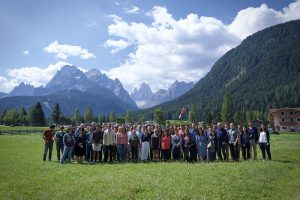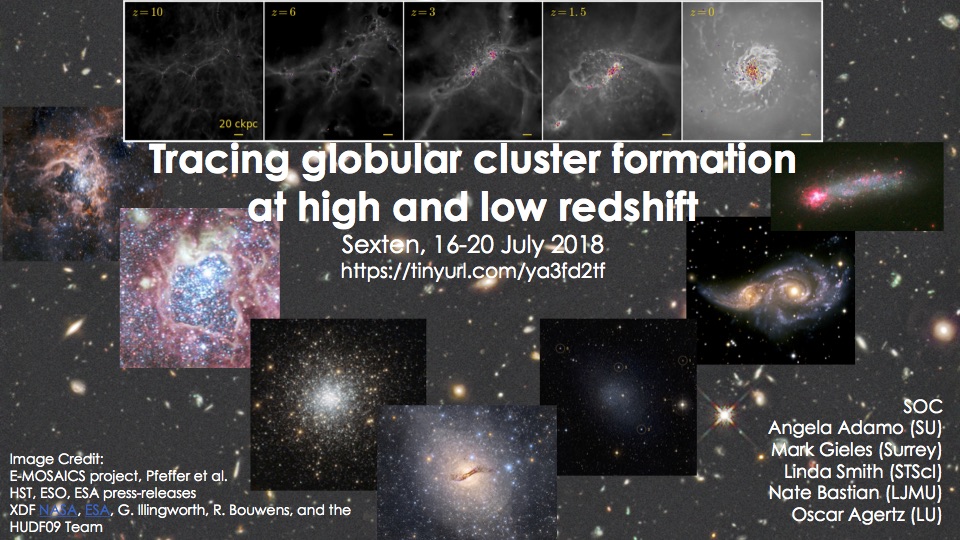
The formation of globular clusters at high and low redshift
LOCATION: Sport & Kurhotel at Bad Moos - Via Val Fiscalina 27, 39030, Sexten
DETAILS
Tracing star and cluster formation across cosmic times
Globular clusters (GCs) are among the first baryonic structures to form at high redshift and they are intimately linked with the formation and earliest phases of galaxy evolution. The metal-poor GCs probe the dark matter of their host galaxy and a tight scaling relation between the mass of the central super-massive black hole and the number of GCs hold over many orders of magnitude. Despite their importance for our understanding of the stellar initial mass function, star formation and chemical evolution of the Universe, their origin and exact role in galaxy formation is still shrouded in mystery.
Thanks to recent observational advances, largely driven by the Hubble Space Telescope (HST), young star clusters have been found in local star-forming galaxies. However, only in extreme star bursts the conditions are met to form young massive clusters (YMCs) with masses comparable to old GCs. The change in the properties of the resulting stellar cluster populations in galaxies at high and low redshift may suggest a change in the gas physical conditions. On the other hand, the formation of YMCs has led to the exciting possibility that local starburst galaxies are windows to star formation at high redshift.
In parallel to the discoveries of YMCs, detailed photometric and spectroscopic studies of the stellar populations of old GCs have revealed an unanticipated complexity of the stellar population and despite various attempts, no signs of such complexities have been found in YMCs. Did old GCs form in a different formation mechanism?
Old GCs have a typical mass of a few 105 solar masses, while YMCs appear to form with a scale-free power-law mass function, with indications for an environmentally dependent truncation at high masses. Reconciling these different mass distributions by different formation mechanism and/or dynamical evolution (i.e. the preferential disruption of low-mass GCs) is a topic of an ongoing debate. Understanding the relative contribution of “nature” and “nurture” is vital to understand the similarities between these two types of objects.
The frequency of GCs relative to field stars increases when considering lower metallicities, reaching near 100% at metallicities of [Fe/H] ~ -2. But there are no GCs known below [Fe/H] ~ -2.5, raising the question whether this absence is a physical limit, or is because there are simply not enough low-metallicity stars to expect at least 1 GC in the Milky Way. The ages of metal-poor GCs are consistent with them having formed soon after or even before the start of reionisation of the Universe, implying that they formed near the transition of PopIII to PopII star formation. It is still an open question what was their exact role in the early stage of chemical enrichment and evolution of galaxies.
In light of the advancement coming from both observational (ground-based facilities like ALMA, MUSE, and space missions like HST, JWST, GAIA) and numerical, this workshop aims to tie the formation of GCs in the early Universe to observational constraints coming from YMCs in nearby starburst environments. Specific questions addressed in this symposium are: Is there a common formation scenario for YMCs and GCs? Where do GCs fall in the transition from PopIII to PopII star formation? What is the origin of the anomalous chemical abundances in old GCs? The workshop has the goal of bringing together experts from different fields to understand the similarities and differences between YMCs and GCs.
The conference will be held from 16-20 July 2018 in Sexten, Italy and will be limited to about 60 participants. Each day will feature a few keynote talks to set the stage and a small number of long talks to present key results relevant for the meeting as well as a number of contributed talks. There will be chance for discussion in small groups and in a few plenary sections. The main topics to be covered are:(i) Clumpy star formation from high to low redshift; how conditions for star formation change across time
(ii) Stellar populations in globular clusters, chemical complexity and link with field stars
(iii) Globular cluster formation, scaling relations, evolution observational constraints and theoretical predictions.
(iv) Young star clusters in local galaxies: formation, scaling relations, evolutions. Are young massive clusters analogs of GCs?
RELATED FILES
Group photo (click here for full resolution)

FEE
300 Eur (250 Eur for PhD students)
WORKSHOP CODE FOR BUS AND PAYMENT
ORGANIZERS
Guidelines for Good Practice
The organisers are committed to conducting meetings that are productive and enjoyable for everyone. This meeting is a place for the open exchange of scientific ideas. Harassment of participants in any form will not be tolerated. The European Astronomical Society Council (EAS) Ethics Statement and Guidelines for Good Practice will apply during the conference. Participants are urged to read the document and follow its recommendations. Any participant who wishes to report any inappropriate behaviour is asked to speak, in confidence, to any of the SOC members attending the meeting (Angela Adamo, Nate Bastian, Mark Gieles, Linda Smith).

